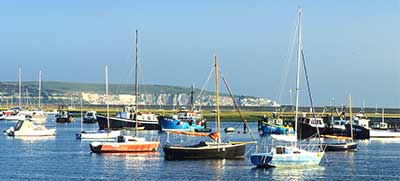Butterflies of Keyhaven, Pennington, Normandy and Hurst
Butterflies in Hampshire can be seen in just about any month of the year, although in winter, only occasional sightings of those that regularly, successfully over-winter as adults - brimstone, small tortoiseshell, peacock and comma - are likely, and then only in spells of mild weather.
From March, greater numbers of butterflies that have over-wintered as adults may be seen, whilst from April, the species that spent winter as chrysalis, for example, large, small and green-veined whites, orange tips and holly blues, take to the wing. Those that spent winter as caterpillars, for example, small coppers and common blues, typically appear from May, whilst those that overwinter as eggs (such as purple hairstreaks), are on the wing from June or July.
(1) Glanville fritillary
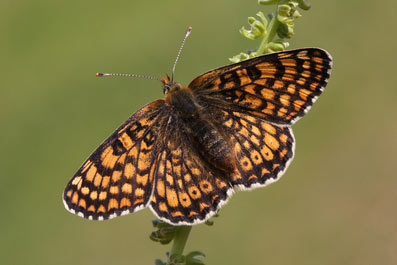
(© Sandra Standbridge | Dreamstime.com)
None of our butterflies are wholly coastal in distribution, but the Glanville fritillary does come close, although in places this beautiful insect also frequents south facing chalk downland. A national rarity that, according to the Millennium Atlas of Butterflies in Britain and Ireland, 'is virtually restricted to coastal sections of the southern half of the Isle of Wight and on the Channel Islands', Glanville fritillaries occur in relatively small numbers around Hurst Castle and along the stretch of coast a little to the west, near Hordle Cliff.
Typically on the wing from mid-May until towards the end of June, Glanville fritillaries are medium sized butterflies with an average wingspan of around 44mm (1¾ inches). As with other fritillary species, the upper wings boast a chequered pattern of blacks and orange browns.
(2) The Wall
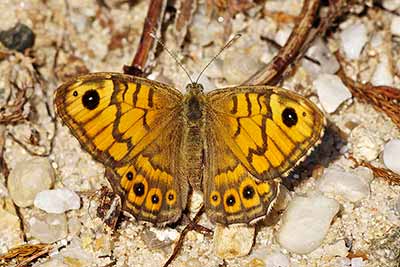
(© Jörg Hempel)
The Wall, or Wall Brown as it is sometimes known, is also nowadays a primarily coastal species, although as recently as 25 years ago it was widely distributed throughout much of England, Wales, Ireland and parts of Scotland. Severe reductions in numbers and distribution have since occurred, though, so-much-so that in Hampshire the seawall and other open spaces between Lymington and Keyhaven have been described as 'the last remaining stronghold in the county for this once widespread and common species'.
Although of similar size and colour to the much more common Gatekeeper butterfly, the Wall's orange upper-wings are much more heavily patterned with dark borders, veins and crosslines. Its first flight period is usually from early May until early June, whilst the second brood often emerges in mid- or late July and is seen until the first half of September. Small third broods sometimes last into October.
(3) A couple of hairstreaks
Other notable species amongst the 30, or so, found locally include green hairstreaks and purple hairstreaks, both of which often go unnoticed.
(Five hairstreak species are found in the UK, all of which have tail-like projections on the lower edge of their hindwing, although this 'tail' is reduced to a sometimes inconspicuous stump in the green hairstreak. Streaks, likened to hairs, on the under surface of the wings account for the hairstreak portion of the name).
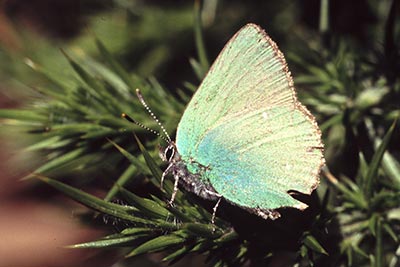
Green hairstreaks are tiny butterflies with an average wingspan of no more than 33mm (1¼ inches). They typically live in small colonies amongst the seawall gorse where they habitually sit with wings closed, showing off the bright green undersides with feint white 'streak', but with the brown uppersides usually totally concealed.
The single generation is on the wing from April until late June, although the prime time is from late May until early June. Territorial males can often be seen perched in the sunshine on favoured gorse bushes as they wait for females to pass by, or else in spiralling flight above the bushes as they battle for supremacy.
Colonial insects of the tree canopy that tend to fly above the trees in the evening, purple hairstreaks are particularly elusive but do occur in and around some of the local, mature hedgerow and other oaks. Another quite small butterfly - they are sometimes likened to a small purple emperor - their average wingspan is 38mm (1½ inches).
Underwings in both males and females are silvery-grey with a white streak and single orange eye near the tail, whilst upperwings in both are dark in colour with in males, a purple sheen, and in females a purple blotch on each forewing. The main adult food source is honeydew taken from the trees, although they may very occasionally visit flowers and in hot, dry weather may also descend to take fluids from ground level.
(4) Other butterfly residents
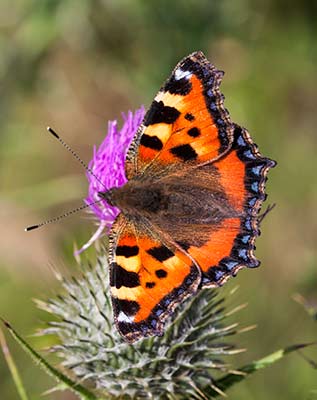
Other butterfly residents include commoner species that often occur in good numbers such as small skippers, large whites, small whites and green-veined whites, orange tips, common blues and holly blues.
And then there are also red admirals, small tortoiseshells, peacocks, commas, speckled woods, marbled whites, gatekeepers, meadow browns and small heaths.
Less frequently seen residents include Essex skippers, large skippers, brimstones, small coppers, dark green fritillaries, silver-washed fritillaries and graylings.
(5) Butterfly migration
Look out here for incoming migrants as the south coast offers an early landfall for many insects travelling north, although the Isle of Wight hogs much of the limelight in this regard and so do places in Hampshire a little east and west along the coast, presumably as butterflies detour around the edges of the Island.
Outgoing migrants in late summer or autumn might also be noticed as, largely unbeknown to casual observers, many migrant butterflies, as with swifts and swallows, head south to warmer climes as cooler weather closes.
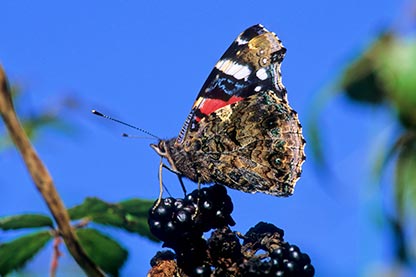
Red admirals, for example, large - their wingspan is from 67mm to 72mm (around 2¾ inches) - strikingly red, black and white butterflies, arrive from North Africa, usually in small numbers, from the second half of May, supplementing the already small numbers that have over-wintered here, or their offspring.
Subsequent local broods are augmented by further, larger numbers of new arrivals leading to a late summer peak in population levels. A complex pattern of migration has then been noted whereby the late summer butterflies undertake a return migration south, whilst a further influx in September and October sometimes occurs.
Another long distance migrant, painted ladies seen in Europe originate from North Africa, the Middle East and central Asia. These, too, are quite large butterflies with an average wingspan of 64mm to 70mm, and it is tempting to assume that size is important for long distance fliers.
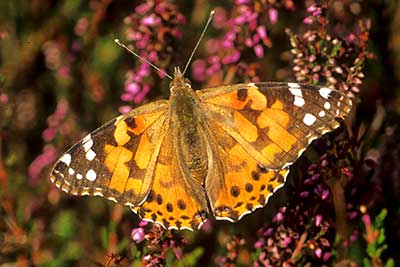
Quite subtly marked with dark patches and white spots against a salmon-pink or dull orange background, painted ladies are occasionally first seen as early as February, but it is not until late May that reasonable numbers can be expected to be present. Numbers do, however, vary markedly - in some years the butterfly is absolutely abundant, whilst in other years relatively few are seen.
Visible late summer and autumn outbound migration is sometimes noted although radar tracking, remarkably, has recorded many instances of these butterflies flying at an altitude of over 500 metres (1,640 feet) and at speeds of up to 50 kph (a little over 30 mph). Adults have been recorded successfully over-wintering but this is exceptional.
And finally, consider the clouded yellow, an insect that has been very accurately described as 'one of the truly migratory European butterflies'. Mass immigrations and subsequent breeding take place intermittently in what become known as 'clouded yellow years', but normally only relatively small numbers make the cross-channel journey, the first arriving from around mid-May.
A little smaller than red admirals and painted ladies but still a substantial insect, the average wingspan of clouded yellows is 57mm to 62mm (a little over 2¼ inches). Autumnal southern migration does take place, although very occasional over-wintering as larvae has been recorded elsewhere on the south coast, with resultant adults noted on the wing from late March.
Parking
'Pay and Display' parking is available in the centre of Keyhaven, opposite The Gun Inn. A limited amount of short stay - up to 4 hours - free parking is available beside the seawall on the road leading past the Avon Water outflow, but space here is at a premium. Further limited parking is available at the end of Lower Pennington Lane. Roadside parking is available close to Hurst Spit, beside New Lane and Saltgrass Lane; and parking is also available at the Lymington end of the seawall path.
References:
The Butterflies of Hampshire: Mathew Oates, John Taverner, David Green et al
Butterflies of the British Isles: JA Thomas
Secret Marsh: Aimee Durnell
One man's marshes - the birds of Lymington and Keyhaven: Ed Wiseman
Lymington-Keyhaven Report 2010
Quick links
More links
Search this site

